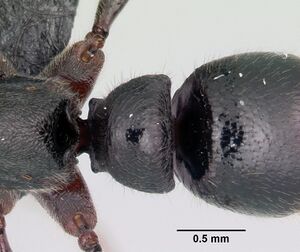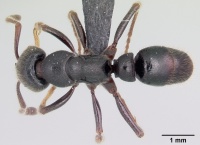Euponera daraina
| Euponera daraina | |
|---|---|

| |
| Scientific classification | |
| Kingdom: | Animalia |
| Phylum: | Arthropoda |
| Class: | Insecta |
| Order: | Hymenoptera |
| Family: | Formicidae |
| Subfamily: | Ponerinae |
| Tribe: | Ponerini |
| Genus: | Euponera |
| Species complex: | sikorae |
| Species: | E. daraina |
| Binomial name | |
| Euponera daraina (Rakotonirina & Fisher, 2013) | |
Specimens have been recorded foraging mostly under leaf litter and rarely on the forest floor.
Identification
Rakotonirina and Fisher (2013) - Worker. Anterior margin of clypeus broadly convex medially; anterior surface of third abdominal segment straight, not forming shallow impression to lodge posterior surface of petiole; posterolateral margins of propodeum and petiolar node without a series of sharp teeth or tubercles, lamellae may be present on posterior margin of propodeum. In dorsal view, petiole node broader, almost twice as broad as long; in profile, subpetiolar process simple with only an anterior triangular lobe.
Keys including this Species
Distribution
Euponera daraina is known only from northern Madagascar, between 800 m and 1100 m elevation, in the forest habitats of Binara near Daraina .
Latitudinal Distribution Pattern
Latitudinal Range: -13.2633° to -13.2633°.
| North Temperate |
North Subtropical |
Tropical | South Subtropical |
South Temperate |
- Source: AntMaps
Distribution based on Regional Taxon Lists
Malagasy Region: Madagascar (type locality).
Distribution based on AntMaps
Distribution based on AntWeb specimens
Check data from AntWeb
Countries Occupied
| Number of countries occupied by this species based on AntWiki Regional Taxon Lists. In general, fewer countries occupied indicates a narrower range, while more countries indicates a more widespread species. |

|
Estimated Abundance
| Relative abundance based on number of AntMaps records per species (this species within the purple bar). Fewer records (to the left) indicates a less abundant/encountered species while more records (to the right) indicates more abundant/encountered species. |

|
Biology
Castes
Known only from the worker caste.
Images from AntWeb
   
| |
| Holotype of Euponera daraina. Worker. Specimen code casent0043301. Photographer April Nobile, uploaded by California Academy of Sciences. | Owned by CAS, San Francisco, CA, USA. |
Nomenclature
The following information is derived from Barry Bolton's Online Catalogue of the Ants of the World.
- daraina. Pachycondyla daraina Rakotonirina & Fisher, 2013: 461, figs. 18, 20, 34, 35, 36, 72 (w.) MADAGASCAR. Combination in Euponera: Schmidt & Shattuck, 2014: 86.
Unless otherwise noted the text for the remainder of this section is reported from the publication that includes the original description.
Description
Worker
(6 specimens): HW: 1.41–1.54, HL: 1.55–1.72, CI: 88–91, SL: 1.20–1.29, SI: 84–85, PW: 1.13–1.25, WL: 2.13–2.26, NH: 0.89–0.97, NL: 0.62–0.63, NW: 0.87–0.98, DNI: 139–156, LNI: 142–155.
With head in full-face view, slightly longer than broad with weakly concave posterior margin and feebly convex lateral margins which converge progressively toward the base of mandibles and without obtuse angle at or strong curve from the insertion of eye. Frontal lobe anteriorly more or less broad, outer margin medially bluntly angulate. Head capsule densely and finely reticulate-punctate, superimposed with small punctures. Eye medium-sized and protruding, with its diameter approximately as large as the widest part of scape. Antennal scape weakly surpassing posterior cephalic margin. Clypeus with weak anteriorly protruding median lobe and bluntly angulate or medially convex anterior margin. Mandible smooth and shiny between sparse piliferous punctulae; masticatory margin equipped with 12 teeth or denticles.
With mesosoma in dorsal view, metanotal groove indistinct; dorsum of mesosoma densely and finely reticulate-rugose, superimposed with small punctures. In profile, mesopleural suture indistinct; lower portion of mesopleuron and propodeum coarsely rugose interspersed with punctures. Posterior margin of propodeum emarginate, without series of sharp teeth or tubercles. Petiole node higher than long in profile; series of sharp teeth absent from convex posterior margin; anterodorsal angle weakly overhanging the anterior face; subpetiolar process anteriorly hook-like and posteriorly subquadrate, separated by a concavity. In dorsal view, node roughly twice as broad as long, with effaced reticulate-punctate sculptures. Anterior face of first gastral segment truncate, without cavity to lodge the posterior surface of petiolar node.
Dorsum of head and seosoma with fewer golden short erect hairs than petiolar node and gaster; pubescence profuse over body dorsum. Integument blackish dark brown with brown ferruginous appendages and tip of gaster.
Type Material
Holotype worker: Antsiranana, Forêt de Binara, 9.4km 235° SW Daraina, -13.2633, 49.6, 1100 m, montane rainforest, sifted litter (leaf mold, rotten wood), 5 Dec 2003 (Fisher et al.), collection code: BLF09800, specimen code: CASENT0043301 (California Academy of Sciences). Paratypes: 2 workers with same data as holotype but specimens coded as: CASENT0043300, CASENT0043302 (CASC).
References
- Rakotonirina, J.C. & Fisher, B.L. 2013. Revision of the Pachycondyla sikorae species-group (Hymenoptera: Formicidae) in Madagascar. Zootaxa 3683, 447-485.
- Schmidt, C.A. & Shattuck, S.O. 2014. The higher classification of the ant subfamily Ponerinae (Hymenoptera: Formicidae), with a review of ponerine ecology and behavior. Zootaxa 3817, 1–242 (doi:10.11646/zootaxa.3817.1.1).
References based on Global Ant Biodiversity Informatics
- Rakotonirina J. C., and B. L. Fisher. 2013. Revision of the Pachycondyla sikorae species-group (Hymenoptera: Formicidae) in Madagascar. Zootaxa 3683 (4): 447-485.

